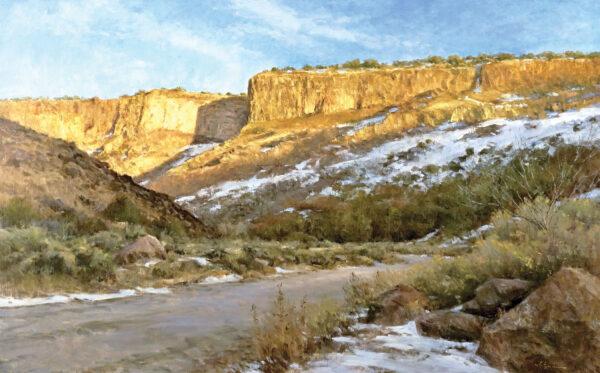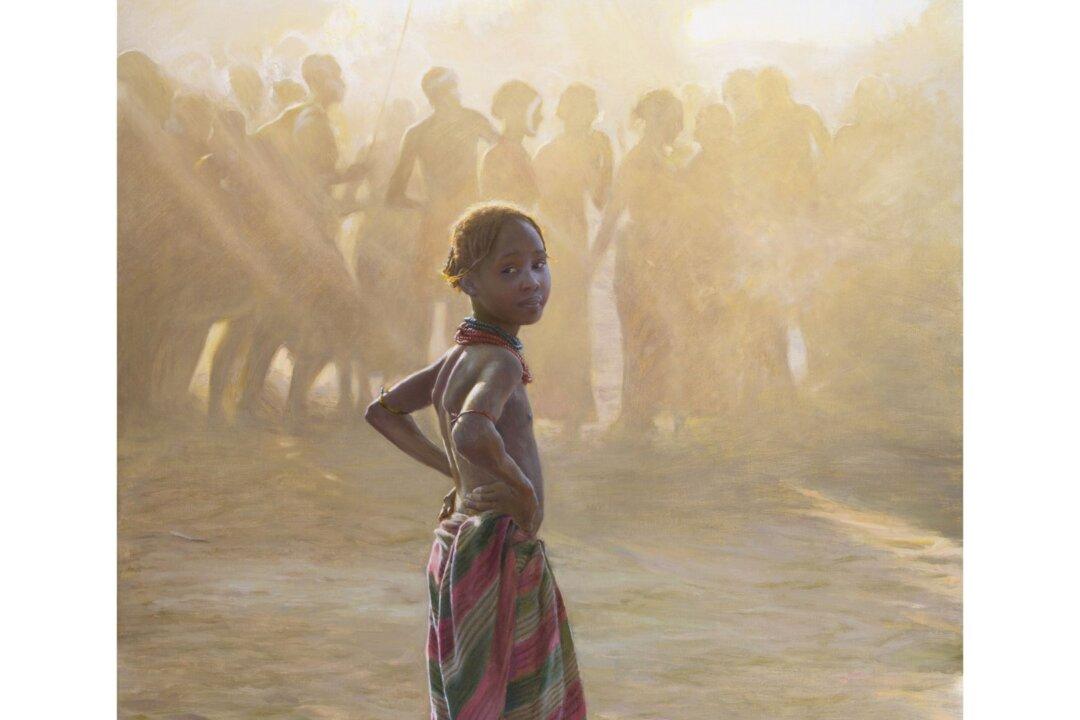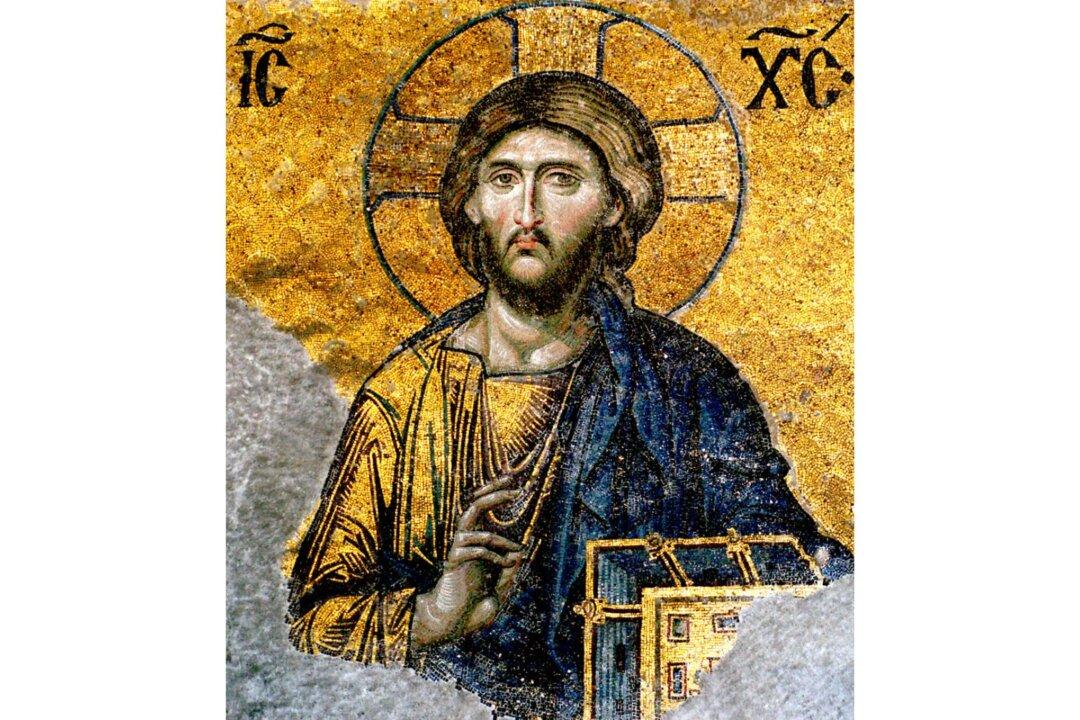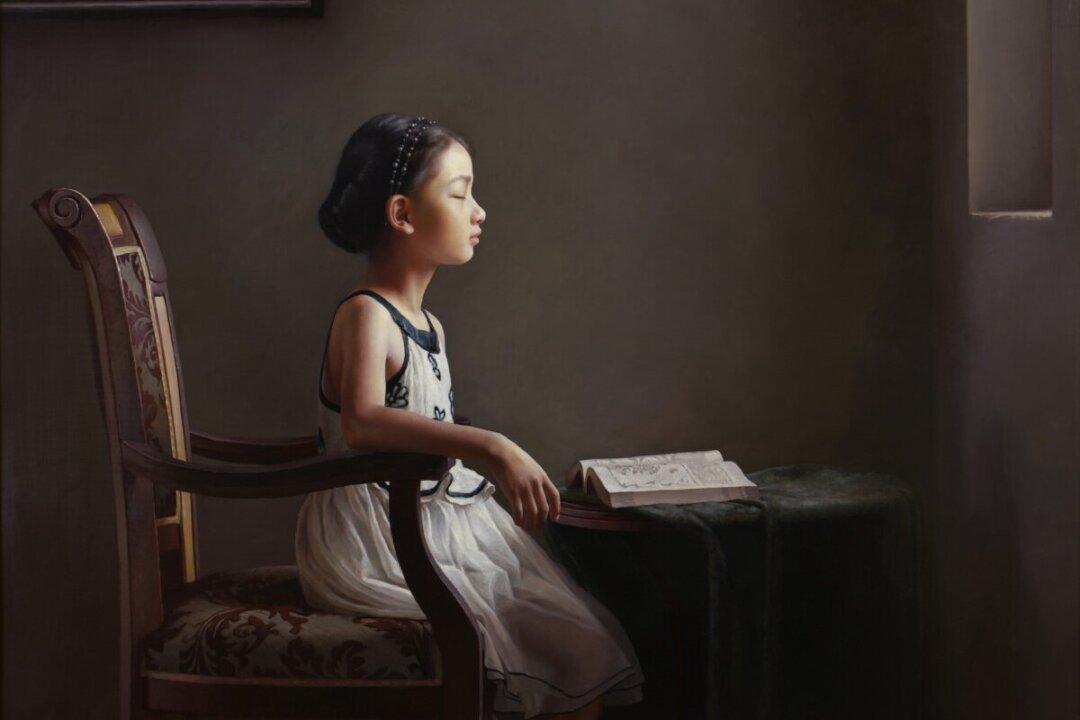Since 1973, the world’s finest Western painters and sculptors have captured cowboy culture for the “Prix de West Invitational Art Exhibition & Sale,” preserving Western traditions and way of life far beyond the plains, prairies, and mountains—and hopefully for generations to come. The 51st exhibition and sale is now open at the National Cowboy & Western Heritage Museum, in Oklahoma City until Aug. 6.

“In the Golden Hour” by John Encinias. Oil on linen; 30 inches by 48 inches. Courtesy of the National Cowboy & Western Heritage Museum
“Every work of art displayed in the show tells a story, and it’s amazing to see a visual representation of the artists’ experiences and relationship to this very special culture,” Museum President and CEO Pat Fitzgerald said in the exhibition press release.
“Prix de West” award winners have been inspired by their Western upbringing, and all are dedicated to preserving and honoring not only the arts that they love but also the Western way of life itself. Through the fine artworks on display, exhibition visitors can glance across vast Western vistas, safely get close to wild animals, and enjoy a day on the ranch or at a festival, to name a few experiences.

Donald Teague Memorial Award: “Prairie Rose” by Joseph Bohler. Transparent watercolor; 24 inches by 34 inches. Courtesy of the National Cowboy & Western Heritage Museum
Many of the artists at the award ceremony on June 10, have been exhibiting at the “Prix de West” for decades. In their acceptance speeches, every award winner acknowledged the peer support that they had gained from one another. Here, we share some of the award-winning artists and their art.
Native Traditions
According to his website, artist John Coleman’s art influences come from eminent cowboy artists Frederic Remington and Charles Marion Russell. He hopes that the subjects of his drawings, paintings, and sculptures move people deeply, as if they were kindred spirits. Of his sculptures, he says: “Each piece tells a story in the three dimensional, a visual mythology written by my hands and spiritual imagination, somehow linking us to the past and bringing us to a greater understanding of our ancestors.”His imposing over-8-foot-tall bronze sculpture “Warrior Spirit, Crazy Horse,” portraying Crazy Horse, a chief of the Oglala subtribe of the Native American Lakota people, won two awards: the Jackie L. Coles Buyers’ Choice Award and the James Earle Fraser Sculpture Award.

James Earle Fraser Sculpture Award and Jackie L. Coles Buyers’ Choice Award: “Warrior Spirit, Crazy Horse” by John Coleman. Bronze; 8 feet 3 inches by 52 inches by 30 inches. Courtesy of the National Cowboy & Western Heritage Museum
In this monumental piece, the fearless chief looks far into the distance, across his shoulder, as if he’s surveying the land. He rests a shotgun in the crook of his arm, and holds a skull cracker in his other hand. His weathered face speaks of wisdom, and his dress and feathers of long-cherished traditions.

Robert Lougheed Memorial Award: “A Watchful Gaze” by Huihan Liu. Oil on linen; 30 inches by 15 inches. Courtesy of the National Cowboy & Western Heritage Museum
Artist Huihan Liu chose to depict Native American life, too, but in oil on linen. He won the Robert Lougheed Memorial Award for four of his paintings: “Autumn Breeze,” “A Watchful Gaze,” “Golden Feather,” and “Heading to Ceremony.” He painted a similar, but gentler, facial expression than Coleman’s Crazy Horse for the Native American in his painting “A Watchful Gaze.” The man stands with his horse, waiting. In “Autumn Breeze,” two women are shown by a fire, wrapping themselves in colorful blankets for warmth. They, too, gaze off into the distance. Liu made this ordinary scene ethereal as fire gently lights the picture and smoke wafts away on the evening breeze.

Robert Lougheed Memorial Award: “Autumn Breeze” by Huihan Liu. Oil on linen; 30 inches by 24 inches. Courtesy of the National Cowboy & Western Heritage Museum

Robert Lougheed Memorial Award: “Heading to Ceremony” by Huihan Liu. Oil on linen; 30 inches by 30 inches. Courtesy of the National Cowboy & Western Heritage Museum

Robert Lougheed Memorial Award: “Golden Feather” by Huihan Liu. Oil on linen; 18 inches by 24 inches. Courtesy of the National Cowboy & Western Heritage Museum
Honoring Ancestors
Artist Gladys Roldan-de-Moras’s canvases celebrate her Mexican heritage. She’s particularly inspired by turn-of-the-century Spanish art. Her painting “Chinas Poblanas” features Mexican dancers and musicians wearing traditional dress. The “china poblana” is Mexico’s national costume for women, as defined in the late 20th century. It consists of a white cotton blouse with a colorful, felted woolen skirt and a shawl, all embellished with a combination of beads, sequins, and prints.Roldan-de-Moras created a festival feeling in her painting with a riot of color, dance, and frolicking that almost has you tapping your toes to the beat.

Frederic Remington Painting Award: “Chinas Poblanas,” by Gladys Roldan-de-Moras. Oil on Belgian linen; 48 inches by 36 inches. Courtesy of the National Cowboy & Western Heritage Museum
She won the Frederic Remington Painting Award for the work and dedicated the award to her late grandfather, a charro (traditional horseman) who also preserved Mexican traditions. He successfully campaigned for “charreria,” traditional herding of livestock using a horse, to be named Mexico’s national sport.
Cowboy Showtime
Artist Blair Buswell won the Express Ranches Great American Cowboy Award for the best cowboy subject matter with his three bronze sculptures: “Showtime,” “Risky Business,” and “Hey, Over HERE!!!”
Express Ranches Great American Cowboy Award: “Risky Business” by Blair Buswell. Bronze; 18 inches by 33 inches by 15 inches. Courtesy of the National Cowboy & Western Heritage Museum
In “Risky Business,” a bull charges a cowboy with such ferocity that one wonders who won that battle, man or beast. Buswell rendered the bull in midair, which is no easy feat, and it is reminiscent of the skill that 19th-century artist Frederic Remington required to execute his famous bronze “The Broncho Buster.”

Express Ranches Great American Cowboy Award: “Hey, Over HERE!!!” by Blair Buswell. Bronze; 11 inches by 10 inches by 10 inches. Courtesy of the National Cowboy & Western Heritage Museum

Express Ranches Great American Cowboy Award: “Showtime” by Blair Buswell. Bronze; 15 inches by 11 inches by 7 inches. Courtesy of the National Cowboy & Western Heritage Museum
Buswell breathes life into his art by design. “I learned that all great art starts with a strong composition that leads the viewer’s eyes through the abstract shapes while keeping him engaged,” he says on his website.
“I just love the opportunity to use our talents to better our world,” he said in his award acceptance speech.
Appreciating the Everyday Beauty of the West
Artist Len Chmiel won the Wilson Hurley Award for Outstanding Landscape for his painting “West I Know: Summarizing Solitude, Utah.” Chmiel captured a spectrum of pinks and ochers as the sun hits the distant sandstone, in contrast to the cool green grasses in the foreground of his painting.
Wilson Hurley Award for Outstanding Landscape: “West I Know: Summarizing Solitude, Utah,” by Len Chmiel. Oil on canvas; 32 inches by 45 inches. Courtesy of the National Cowboy & Western Heritage Museum
On winning the award, Chmiel said: “It’s really fulfilling because I love the landscape. It is a really important part of my life, ... and I try to translate my feelings about the landscape and all of its variabilities to paint canvas.”
Artist Walter T. Matia’s bronze sculpture “Molly Is a Working Girl” won the Prix de West Purchase Award, earning a place in the permanent collection of the National Cowboy & Western Heritage Museum.

Prix de West Purchase Award: “Molly Is a Working Girl,” by Walter T. Matia. Bronze; 38 inches by 25 inches by 16 1/2 inches. Courtesy of the National Cowboy & Western Heritage Museum
In his acceptance speech, Matia said that people experience the West in different ways: “I’ve always been behind a bird dog, or in a stream with a fly rod, or I’ve been on some marsh, looking at birds with binoculars.” These experiences placed him in good stead to create his convincing wildlife art. In his winning bronze, Molly, poised, seems to have spotted a bird as she looks up attentively, trying not to alert her prey.
Matia’s sculpture represents the everyday West beyond the iconic cowboy scenes. He’s happy that the judges chose the piece. “It spoke to a part of the West that I don’t think is always acknowledged: the role of the hunter and fisherman in both opening up the West initially but also now conserving the West,” he says.
The Prix de West celebrates all aspects of the West and the finest artists of the Western art genre for the world to see. But more than that, Prix de West committee chairman Susan J. Roeder stressed at the live auction the importance of these artworks beyond their aesthetic appeal. “Being surrounded by this kind of beauty on a daily basis can lift our moods, can elevate our thinking, [and] it informs our worldview, and the way that we move through life in a positive way without us even realizing it.”
The “Prix de West Invitational Art Exhibition & Sale” at the National Cowboy & Western Heritage Museum, in Oklahoma City, runs through Aug. 6. Available artworks can be purchased online. To find out more, visit PDW.NationalCowboyMuseum.org






